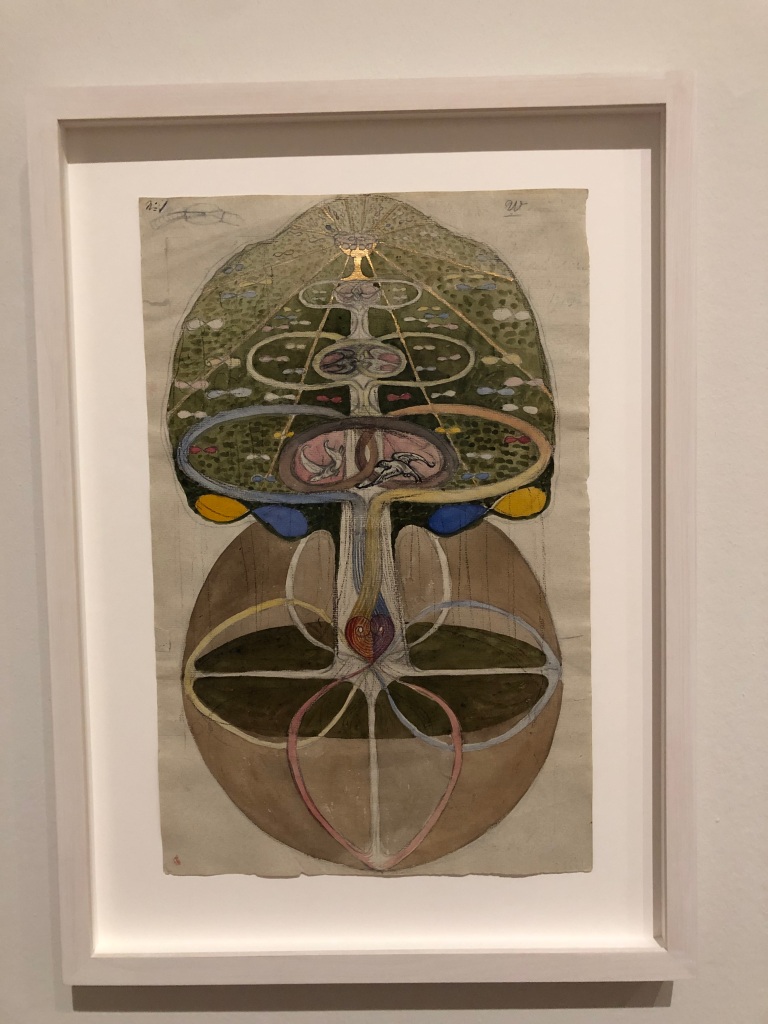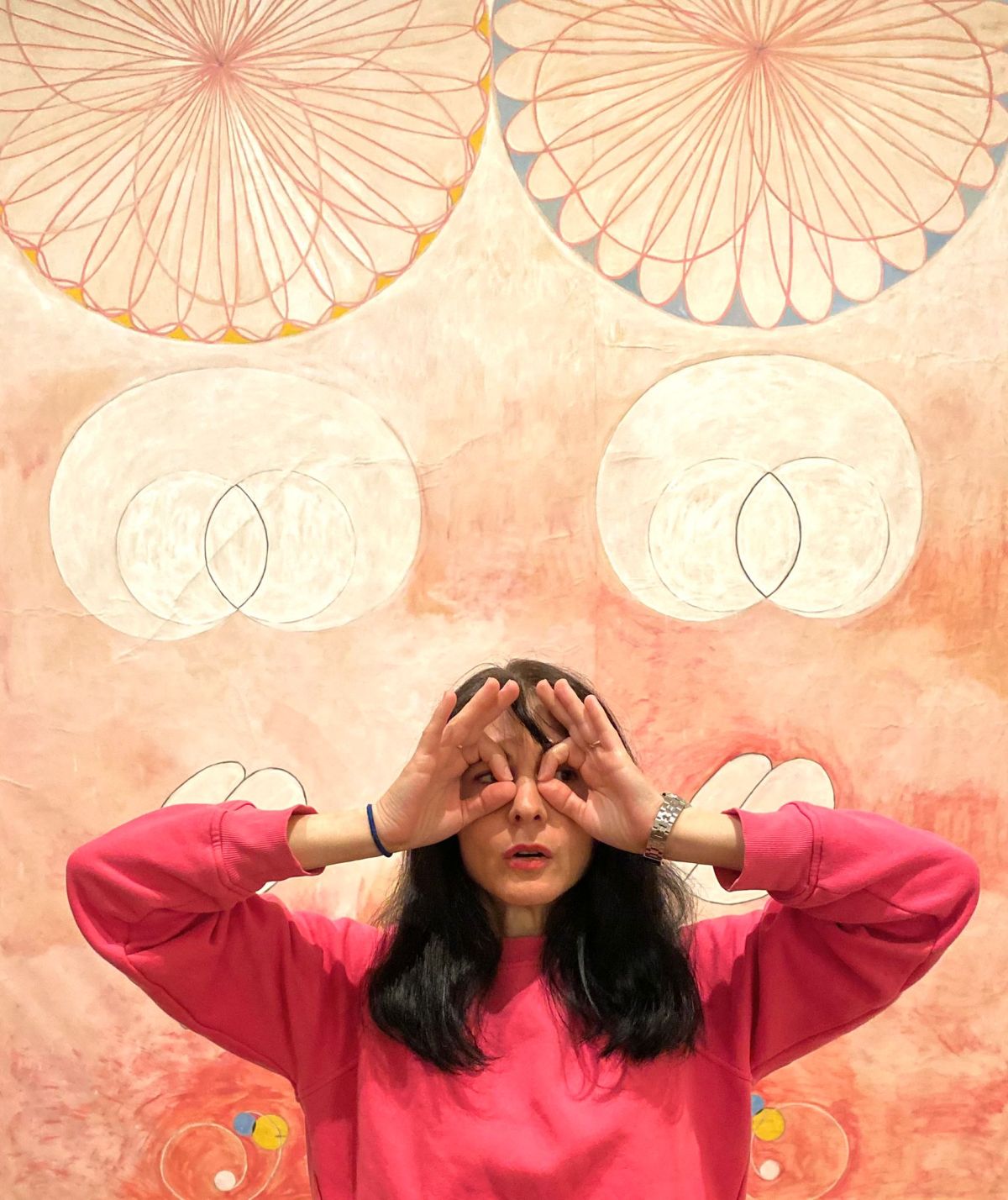The last art show I saw at Tate Modern was “Hilma af Klint & Piet Mondrian: Forms of Life”. Although they never met in real life, the Swedish and the Dutch artists come together in this exhibition to explore how their nature-inspired abstract art developed.
Despite their mutual interest in spirituality and in abstract form, I believe that the evolution experienced by both artists was very different. Nonetheless, I was pleased to discover af Klint’s work for the first time in this exhibition, and I was delighted to see many of the paintings created by both artists and displayed here.
Hilma af Klint (1862-1944) was a Swedish artist and mystic whose paintings are considered among the first abstract artworks in western art history. She belonged to a group called “The Five” – a circle of women inspired by Theosophy, who tried to contact the “high masters” by way of séances.
At her death, Af Klint left instructions for her works not to be shown in public for another 20 years. she believed audiences of the future might be more receptive to her esoteric paintings. And she was proved right, when the Guggenheim’s 2018 retrospective became more than seven decades later the biggest hit in the museum’s history.
Piet Mondrian (1872-1944) was a Dutch painter and art theoretician who is regarded as one of the greatest artists of the 20th century. He is known for being one of the pioneers of 20th-century abstract art, as he changed his artistic direction from figurative painting to an increasingly abstract style, until he reached a point where his artistic vocabulary was reduced to simple geometric elements. Mondrian’s art was highly utopian and was concerned with a search for universal values and aesthetics.
He co-founded the De Stijl art movement with Theo van Doesburg and evolved a non-representational form which he termed Neoplasticism. This was the new ‘pure plastic art’ which he believed was necessary in order to create ‘universal beauty’.
From the beginning of the exhibition, it’s easier to associate both artists since both appear to be thinking about art through nature. The juxtaposition of their work don’t seem to be competitive and their works are displayed on different walls. Af Klint’s botanical studies are grouped alone in all their delicate and prolific detail. Whereas, Mondrian paints the same apple tree many times, with an almost Japanese devotion.
However, the love that Mondrian shared with the De Stijl movement for primary colours and black lines is showcased minimally in this art show. Like the changes he experienced by encountering the various art movements of his time in Paris that led him to develop such a personal and iconic style.
The exhibition surprises you when it comes to getting to know Hilma af Klint’s work though. The artist was hardly known by her contemporaries and is frequently compared with 21st century artists since she was a lesbian, feminist, anti-establishment and a restless radical involved in women’s cooperatives.
In this art show, we seem to be confronting a modernist with a postmodernist artist. Although both lived almost at the same time (Mondrian was born 10 years later) and both died on the same year. Mondrian, like other modernists, focused on simplicity and elegance with colour, shape, and form, while promoting utopian ideals. By contrast, af Klint used her art to express her unique interpretation on spirituality based on experience.
Modern art is more associated with male artists, while Postmodern art features contributions from different genders, ethnicities, and classes. Modernist abstract painting in the 20th century found meaning in colours, logic in the lines and an internal coherence. Modernist artists worked towards an idealized version of artistic beauty. Postmodern art, however, rejects the idea that there is a right way to make art, is considered elaborate and decorative, and is based on chance.
In conclusion, the art show is interesting when it comes to confronting two different ways of understanding and creating art, both very related to the evolution of art in the last century. But their artistic journeys, from being inspired by nature to creating magnificent abstract paintings are very far from each other.
With Hilma af Klint, you see how she explores her beliefs through art. She channelled visions received from a spirit world to create exuberant and decorative works of art that have only started to be discovered and understood recently. With Piet Mondrian, you can perceive the evolution of art in the first half of last century. He went through inner and outer changes stimulated by mixing with the revolutionary art movements of his time, and ended up creating unique and iconic artworks that continue being an inspiration for generations of artists today.
Read the Spanish version below the pictures.











Mondrian



Arte abstracto inspirado en la naturaleza
Hilma Af Klint y Piet Mondrian
Formas de vida
20 de abril – 3 de septiembre de 2023
Tate Modern, Londres, Reino Unido
La última muestra de arte que vi en la Tate Modern fue “Hilma af Klint & Piet Mondrian: Forms of Life”. Aunque nunca se conocieron en la vida real, la pintora sueca y el pintor holandés se reúnen en esta exposición para explorar cómo se desarrolló su arte abstracto inspirado en la naturaleza.
A pesar de su mutuo interés por la espiritualidad y la forma abstracta, la evolución experimentada por ambos artistas fue muy diferente. No obstante, me agradó descubrir el trabajo de af Klint por primera vez en esta exposición, y me encantó ver muchas de las obras expuestas de ambos artistas.
Hilma af Klint (1862-1944) fue una artista y mística sueca cuyas pinturas se consideran entre las primeras obras de arte abstractas en la historia del arte occidental. Pertenecía a un grupo llamado “Las Cinco”, un círculo de mujeres inspiradas en la Teosofía, que intentaban contactar a los llamados “maestros superiores” a través de sesiones de espiritismo.
Tras su muerte, af Klint dejó instrucciones para que sus obras no se mostraran en público durante otros 20 años. Creía que el público del futuro sería más receptivo a sus pinturas esotéricas. Y se demostró que tenía razón cuando la retrospectiva del Guggenheim de 2018 se convirtió más de siete décadas después en el mayor éxito en la historia del museo.
Piet Mondrian (1872-1944) fue un pintor y teórico del arte holandés, considerado uno de los más grandes artistas modernistas del siglo XX. Es conocido por ser uno de los pioneros del arte abstracto del siglo XX, que cambió su dirección artística de la pintura figurativa a un estilo cada vez más abstracto, hasta llegar a un punto en el que su vocabulario artístico se redujo a simples elementos geométricos. El arte de Mondrian era muy utópico y se preocupaba por la búsqueda de valores y estéticas universales.
Cofundó el movimiento artístico De Stijl con Theo van Doesburg y desarrolló una forma no figurativa que denominó Neoplasticismo. Este era el nuevo ‘arte plástico puro’ que creía necesario para crear la ‘belleza universal’.
Desde el comienzo de la exposición, es más fácil asociar a ambos artistas, ya que ambos parecen estar pensando en el arte a través de la naturaleza. La yuxtaposición de su trabajo no parece ser competitiva y sus obras se exhiben en paredes diferentes. Los estudios botánicos de af Klint se agrupan solos en todo su delicado y prolífico detalle. Mientras que Mondrian pinta muchas veces el mismo manzano, con una devoción casi japonesa.
Sin embargo, la predileción por los colores primarios y las líneas negras que Mondrian compartió con el movimiento De Stijl se muestra mínimamente en esta exposición, así como los cambios que experimentó al encontrarse en París con los diversos movimientos artísticos de su tiempo que le llevaron a desarrollar un estilo tan personal e icónico.
Eso sí, la exposición sorprende a la hora de conocer la obra de Hilma af Klint. La artista apenas era conocida por sus contemporáneos y es frecuentemente comparada con artistas del siglo XXI. Era lesbiana, feminista, antisistema, radical e involucrada en las cooperativas de mujeres.
En esta exposición de arte, parece que estamos confrontando a un artista modernista con un artista posmoderno. Aunque ambos vivieron casi al mismo tiempo (Mondrian nació 10 años después) y ambos fallecieron el mismo año. Mondrian, como otros modernistas, se centró en la simplicidad y la elegancia, en el color y la forma, al tiempo que promovía ideales utópicos. Por el contrario, af Klint usa su arte para expresar su interpretación única de la espiritualidad, basada en la experiencia.
El arte moderno está más asociado con artistas masculinos, mientras que el arte posmoderno presenta contribuciones de diferentes géneros, etnias y clases. La pintura abstracta modernista del siglo XX encuentra coherencia interna y lógica en las líneas y colores que emplea. Los artistas modernistas trabajaron hacia una versión idealizada de la belleza artística. El arte posmoderno, sin embargo, rechaza la idea de que existe una forma correcta de hacer arte, se considera elaborado y decorativo, y se basa en el azar.
En conclusión, la muestra de arte resultó interesante a la hora de confrontar dos formas diferentes de entender y hacer arte muy relacionadas con la evolución del arte en el siglo pasado. Pero sus trayectorias artísticas, desde inspirarse en la naturaleza hasta crear magníficas pinturas abstractas, están muy lejos la una de la otra.
Con Hilma af Klint, ves cómo exploraba sus creencias a través del arte. Canalizaba las visiones recibidas de un mundo espiritual para crear obras de arte exuberantes y decorativas que apenas han comenzado a ser descubiertas y comprendidas recientemente. Con Piet Mondrian, se puede percibir la evolución del arte en la primera mitad del siglo pasado. Pasó por cambios internos y externos estimulado por la influencia de los movimientos artísticos revolucionarios de su tiempo, y terminó creando obras de arte únicas e icónicas que siguen siendo una inspiración para generaciones de artistas actualmente.
Sources: Tate website, The Guardian, Wikipedia.

